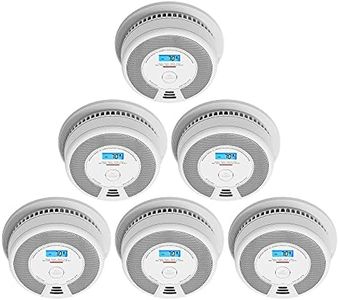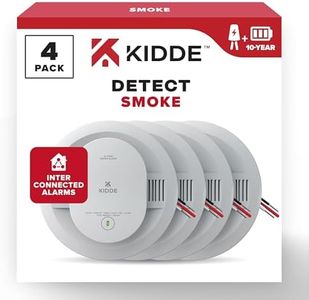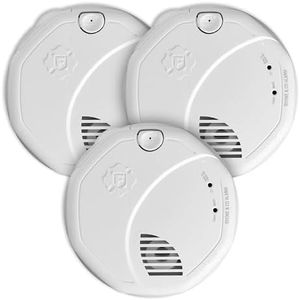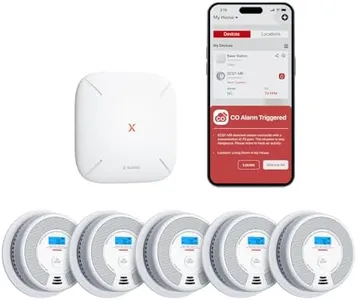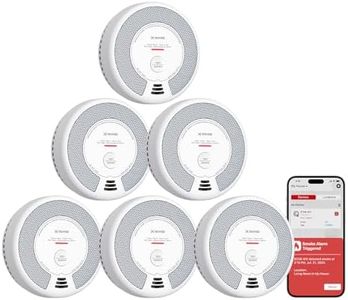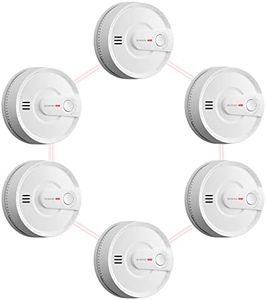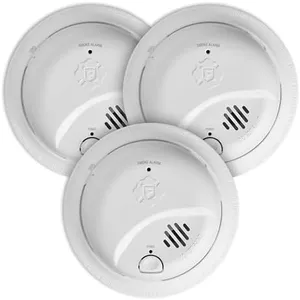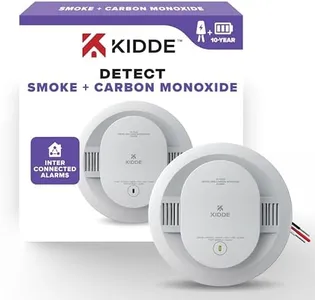10 Best Interconnected Smoke Alarms 2025 in the United States
Our technology thoroughly searches through the online shopping world, reviewing hundreds of sites. We then process and analyze this information, updating in real-time to bring you the latest top-rated products. This way, you always get the best and most current options available.

Our Top Picks
Winner
X-Sense Wireless Interconnected Combination Smoke and Carbon Monoxide Detector with LCD Display & 10-Year Battery, Over 820 ft Transmission Range, 6-Pack
Most important from
5284 reviews
The X-Sense Wireless Interconnected Combination Smoke and Carbon Monoxide Detector is a solid choice for those seeking comprehensive safety solutions in their homes. One of its standout features is the interconnected system; when one unit detects smoke or carbon monoxide (CO), all alarms in the network sound off, ensuring that you receive timely warnings no matter where you are in the house. This is particularly beneficial for larger homes, as you can connect up to 24 devices, creating a wide coverage area. Each unit is equipped with both a photoelectric smoke sensor and an electrochemical CO sensor, providing reliable detection for both hazards.
Another advantage is the built-in 10-year lithium battery, which means you won't have to worry about changing batteries regularly. The informative LCD display shows real-time CO levels and battery status, adding a layer of convenience and transparency.
The X-Sense detector is a reliable and user-friendly option for those prioritizing safety in their homes. It offers important features and solid performance.
Most important from
5284 reviews
First Alert SMICO100-AC Interconnect Hardwire Combination Smoke & Carbon Monoxide Alarm with Battery Backup - 3 Pack
Most important from
27278 reviews
The First Alert SMICO100-AC is a 3-pack of smoke and carbon monoxide alarms designed to offer reliable, interconnected home safety. One of its strong points is the interconnectivity feature: when one alarm detects danger, all the alarms sound, providing a quick alert throughout your home. It uses ionization sensors, which are good at detecting fast-flaming fires, and the Precision Detection technology helps reduce false alarms from cooking, which many users will appreciate.
Powered by corded electric with a battery backup, these alarms stay active even during power outages, adding peace of mind. Installation is made simpler with the Quick Connect Plug, so you don't need to do complex rewiring, making it a good choice for users who want straightforward setup. The test/silence button also helps with easy maintenance by letting you check the alarm’s function or silence it without hassle.
A limitation is that ionization sensors are less sensitive to slow-smoldering fires compared to photoelectric sensors, so it might miss certain types of smoke. The alarms don’t include advanced smart features like smartphone alerts or voice control, which some newer models offer. They also require regular battery replacement for the backup function, so some upkeep is necessary. This pack suits homeowners looking for dependable, easy-to-install alarms with solid interconnectivity and dual smoke and CO detection, without needing extra smart capabilities.
Most important from
27278 reviews
Kidde Hardwired Smoke Detector, 10-Year Battery Backup, Interconnectable, LED Warning Light Indicators, 4 Pack
Most important from
1140 reviews
The Kidde Hardwired Smoke Detector is a reliable choice for those looking for interconnected smoke alarms. It features a hardwired installation with a 10-year battery backup, which means it remains operational even during power outages and reduces the hassle of frequent battery changes. The interconnect capability ensures that when one alarm triggers, all others will sound, providing comprehensive home protection. The photoelectric sensor is designed to minimize false alarms usually caused by cooking, which is a common concern in many households.
Installation might be a bit involved since it requires 120V AC wiring, making it more suitable for permanent residences rather than temporary setups. However, once installed, the 10-year warranty and the maintenance-free battery life can offer peace of mind. The alarm at 85 decibels is quite loud, ensuring you'll be alerted in case of an emergency.
Smart features include LED indicators for different statuses: green for regular operation, amber for errors, and red for smoke detection. The self-testing function is a nice touch, although users are still encouraged to perform manual tests regularly. Additionally, the Test & Hush button helps in testing the device and silencing false alarms. Kidde's smoke detector is well-suited for individuals looking for a durable and efficient smoke detection system with minimal maintenance. While it might not have advanced smart-home integration features, its focus on safety and reliability makes it a solid investment for home security.
